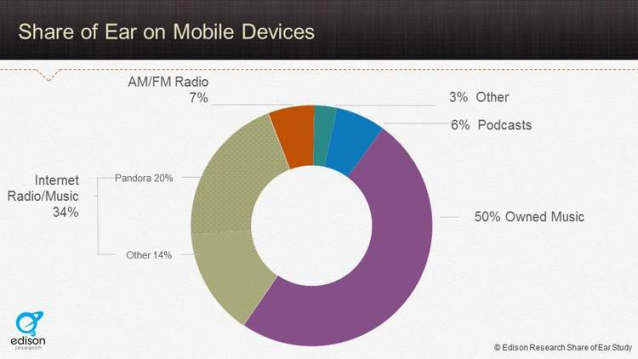 This guest column is contributed by Larry Rosin, President of Edison Research. It was first published on The Infinite Dial blog.
This guest column is contributed by Larry Rosin, President of Edison Research. It was first published on The Infinite Dial blog.
In my past post, which one can read here, I started my inquiry into where radio station simulcasts fit in the online environment. The data from Triton Digital, our Infinite Dial studies, the unique project we performed in Austria, and plenty of other sources show that virtually all the momentum in the online audio space is coming from “Pureplays” — audio services built for consumption in the mobile, smartphone, responsive environment.
The widely noted data from Triton shows all usage for online audio sources. In our Share of Ear (SM) studies, we ask our diary-keepers to tell us what device they consume their audio on, and one category is “Mobile Devices” which includes phones, tablets or iPod/MP3 players. This allows us to divide the world of audio more narrowly. I recently wrote a post on the Edison Research blog called “Share of Ear on Mobile Devices” which updated these numbers and included the graph below:
Our nationally-representative sample shows that the top form of audio consumed on mobile devices is ‘owned music’ at 50% of users’ time. Looking at the other half of mobile consumption, we see that by far the largest amount of time goes to a single app — Pandora. Two-fifths of the non-owned half of the mobile pie goes to the colossus from Oakland. Other Internet ‘pureplays’ (such as Spotify, iTunes radio, etc) gets 14% of the total, and listening to AM/FM content on a mobile device gets 7%, just a tad higher than podcasts. Details on Edison’s Share of Ear studies, including methodology statement, can be found on the Edison website www.edisonresearch.com.
While I’m not aware of an authoritative count, many thousands of American AM and FM radio stations have their content available on mobile devices, either on a station app or an aggregator like TuneIn, iHeart, or Radio.com, There is also listening on the new NextRadio app. Radio stations spend billions in paid-equivalent value promoting these apps. And yet, all rolled into one they are getting one-third the listening that Pandora is seeing, and one-fifth of the combined pureplay listening.
There are at least two factors driving this outcome: Technology and Content. Each plays a role in the outcome we are seeing in the mobile space. In my next post I will take these up as I continue my examination of whether (and how) radio station simulcasts can compete in the smartphone world.

